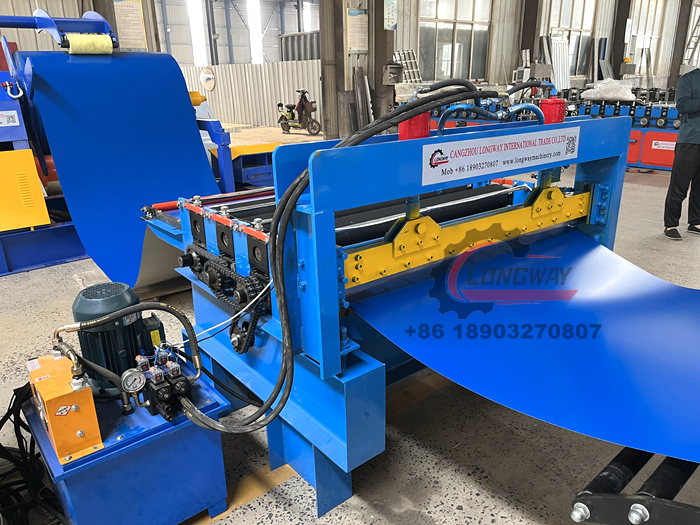Innovative Solutions for Efficient Standing Seam Panel Production Machinery
The Advantages and Applications of Standing Seam Forming Machines
Standing seam systems have become increasingly popular in the roofing industry due to their durability, weather resistance, and aesthetic appeal. At the heart of this advanced roofing technology is the standing seam forming machine, a specialized piece of equipment designed to create high-quality metal panels for standing seam roofs. This article explores the benefits, features, and applications of standing seam forming machines.
What is a Standing Seam Forming Machine?
A standing seam forming machine is a type of roll forming equipment that is used to produce metal roofing panels with interlocking seams. These machines take flat metal sheets, typically made of steel or aluminum, and transform them into standing seam panels through a series of forming processes. The resulting panels feature raised seams that run vertically along the roof, providing a durable and aesthetically pleasing finish.
Benefits of Using Standing Seam Forming Machines
1. Enhanced Durability Standing seam roofs are known for their longevity. The roll forming process allows for precise control over material thickness and shape, ensuring a strong and durable product. Moreover, the elevated seams prevent water pooling, which reduces the risk of leaks and water damage.
2. Weather Resistance The design of standing seam roofs makes them highly resistant to various weather conditions. This is particularly advantageous in areas prone to heavy rain, snow, or high winds. The raised seams help facilitate water runoff and reduce the chances of ice damming.
3. Aesthetic Appeal Standing seam roofs provide a sleek and modern look that can enhance the architectural design of a building. With various color options and finishes available, these roofs can complement a wide range of styles, from contemporary to traditional.
4. Energy Efficiency Many standing seam panels come with reflective coatings that can help reduce energy costs by minimizing heat absorption. This makes them an attractive choice for energy-conscious builders and homeowners.
5. Ease of Installation Standing seam forming machines are designed for efficiency. They can quickly produce large volumes of panels, significantly speeding up the installation process. Additionally, the interlocking nature of the seams simplifies the panel installation, reducing labor time and costs.
standing seam forming machine

6. Flexibility These machines can be adjusted to produce panels of varying widths and profiles, allowing manufacturers to meet custom specifications. This flexibility makes standing seam forming machines suitable for various projects, from residential to commercial.
Applications of Standing Seam Forming Machines
Standing seam forming machines serve a variety of applications across different sectors
- Residential Roofing Homeowners increasingly choose standing seam roofs for their aesthetic appeal and durability. The flexibility of the forming machine allows for custom designs and colors to match individual preferences.
- Commercial Buildings Many commercial structures favor standing seam roofs for their low maintenance and longevity. Large-scale buildings can benefit from the rapid production capabilities of forming machines, enabling timely project completion.
- Industrial Facilities In industrial settings, standing seam roofs provide the durability needed to withstand harsh environments and extreme weather conditions. Their ability to integrate with insulation systems further enhances energy efficiency.
- Agricultural Structures Agricultural buildings often require roofing that can endure significant exposure to the elements. Standing seam roofs are ideal for barns and storage facilities, as their design prevents moisture penetration.
Conclusion
Standing seam forming machines play a crucial role in the production of modern roofing solutions. Their ability to create durable, weather-resistant, and aesthetically pleasing panels means they are an excellent investment for both manufacturers and consumers. As the demand for energy-efficient and long-lasting building materials continues to rise, the relevance of standing seam roofs and the machines that produce them will only increase. By understanding the benefits and applications of these machines, stakeholders in the construction industry can make informed decisions that lead to improved building performance and longevity.
-
Roof Panel Machines: Buying Guide, Types, and PricingNewsJul.04, 2025
-
Purlin Machines: Types, Features, and Pricing GuideNewsJul.04, 2025
-
Metal Embossing Machines: Types, Applications, and Buying GuideNewsJul.04, 2025
-
Gutter Machines: Features, Types, and Cost BreakdownNewsJul.04, 2025
-
Cut to Length Line: Overview, Equipment, and Buying GuideNewsJul.04, 2025
-
Auto Stacker: Features, Applications, and Cost BreakdownNewsJul.04, 2025
-
Top Drywall Profile Machine Models for SaleNewsJun.05, 2025








